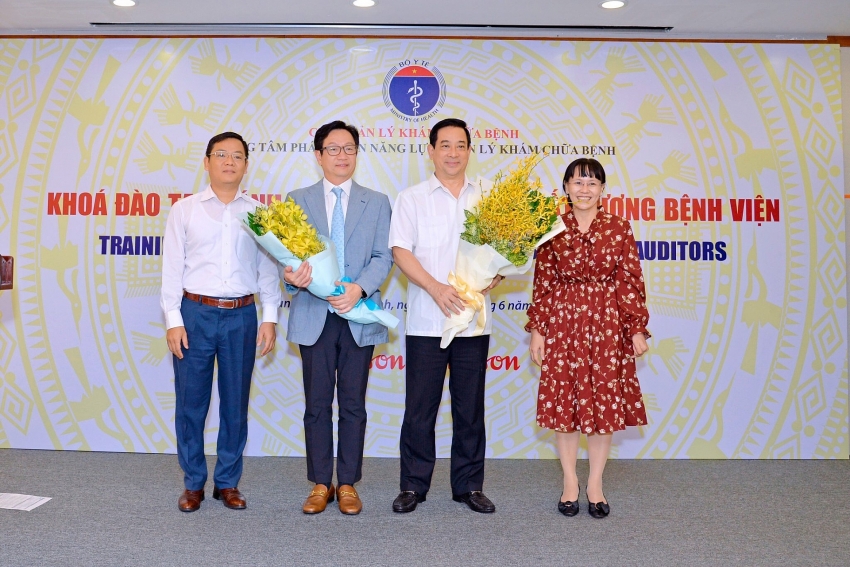Improving the quality of medical examination and hospital treatment
This is the second training course organised by the MoH in order to standardise hospital quality assessment auditing in the southern region and was organised under the sponsorship of Johnson & Johnson.
During the five-day course, from June 25-29, the participants have been trained on hospital quality assessment, basic principles and methods of assessing hospital quality, guidelines on evaluation according to the set of 83 criteria for assessing hospital quality, sharing experiences in organising a hospital quality assessment auditor team, and practices of hospital quality assessment.
 |
| Jun Hong Park (second from left) and associate prof. Luong Ngoc Khue (third from left) received flowers from participants |
In his opening speech, associate prof. Luong Ngoc Khue, director of the Medical Examination and Treatment Management Department and director of the training centre, said that hospital quality assessment is not a task that is only carried out at the end of the year. Instead, it must be a daily chore. Each hospital is a miniature society, with different day-to-day activities, so quality assessment auditors must understand the principles for continuous improvement.
In the past five years, the medical examination and treatment system has implemented the set of 83 criteria for hospital quality assessment. This set includes 83 criteria and 1,595 sub-sections which are on par with the most advanced quality assessment criteria set in the world. This set of criteria is both scientifically and practically designed, while each criterion is divided into five levels (equal to five stars of quality) so each hospital can strive depending on their situation.
The quality improvement activities have been accompanied with positive support from the boards of directors of many hospitals, and therefore the quality has changed significantly. In such, hospital quality assessment has played an important role in assisting hospitals to continually improve their patient-serving quality. The hospitals are now changing methodologies according to the hospital’s quality standards set with the aim “Patients are the centre.”
Speaking at the opening ceremony, Jun Hong Park, managing director of Jonhson & Johnson (Vietnam) said, “As a healthcare company, we are deeply aware that the quality of medical services is very important, one of the measures of patient’s satisfaction as well as of medical staff at all medical examination and treatment facilities.”
For over 20 years in Vietnam, Johnson & Johnson has been partnering with the MoH, hospitals, specialised associations, medical universities, and many medical training centres, in further improving the medical training quality for doctors, nurses, and medical staff to aim at a high-quality healthcare industry.
What the stars mean:
★ Poor ★ ★ Promising ★★★ Good ★★★★ Very good ★★★★★ Exceptional
Related Contents
Latest News
More News
- Businesses ramp up production as year-end orders surge (December 30, 2025 | 10:05)
- Vietjet chairwoman awarded Labour Hero title (December 29, 2025 | 13:06)
- How to unlock ESG value through green innovation (December 29, 2025 | 10:03)
- AI reshapes media and advertising industry (December 29, 2025 | 08:33)
- FPT and GELEX sign deal to develop blockchain tech for global markets (December 29, 2025 | 08:29)
- Vietnam’s GDP forecast to grow by 9 per cent in 2026 (December 29, 2025 | 08:29)
- Women entrepreneurs are key to Vietnam’s economic growth (December 29, 2025 | 08:00)
- Vietnam's top 500 value-creating enterprises announced (December 27, 2025 | 08:00)
- The PAN Group shaping a better future with ESG strategy (December 26, 2025 | 09:00)
- Masan Consumer officially lists on HSX, marking the next phase of value creation (December 25, 2025 | 13:20)

 Tag:
Tag:























 Mobile Version
Mobile Version